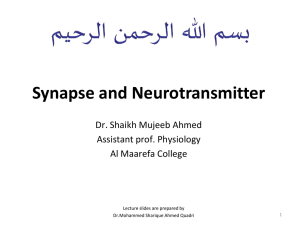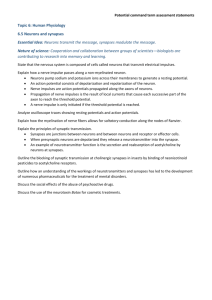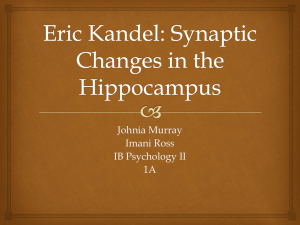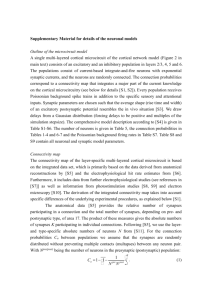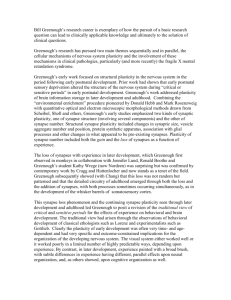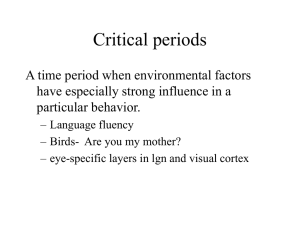EncycloLearnMemory - The University of Illinois Archives
advertisement
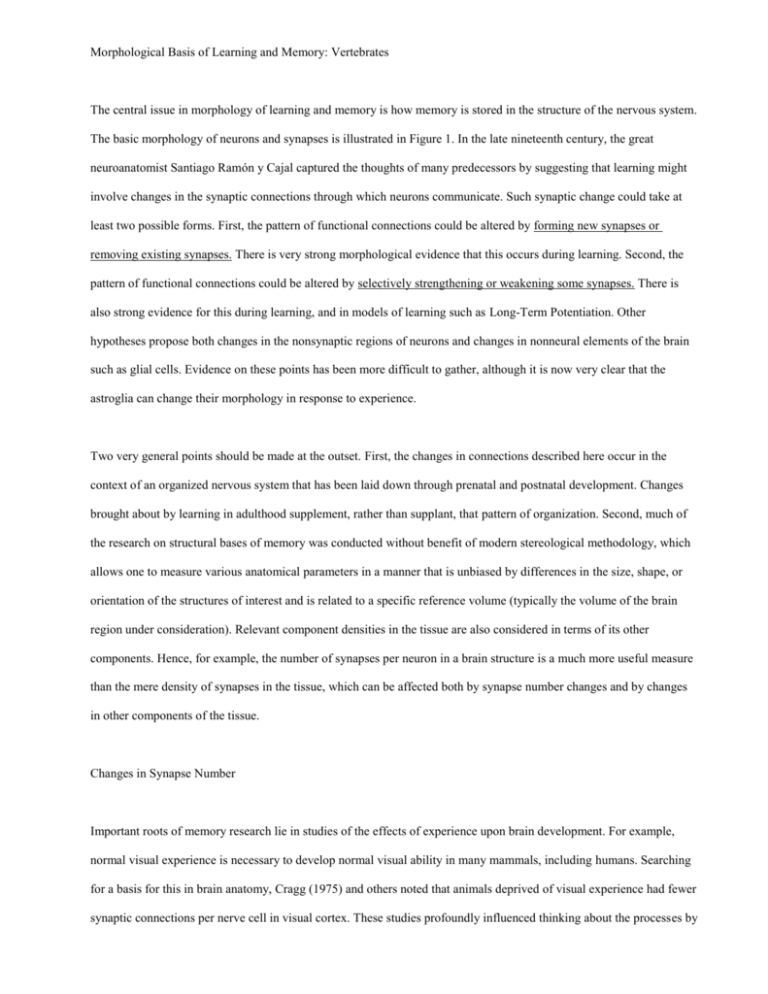
Morphological Basis of Learning and Memory: Vertebrates The central issue in morphology of learning and memory is how memory is stored in the structure of the nervous system. The basic morphology of neurons and synapses is illustrated in Figure 1. In the late nineteenth century, the great neuroanatomist Santiago Ramón y Cajal captured the thoughts of many predecessors by suggesting that learning might involve changes in the synaptic connections through which neurons communicate. Such synaptic change could take at least two possible forms. First, the pattern of functional connections could be altered by forming new synapses or removing existing synapses. There is very strong morphological evidence that this occurs during learning. Second, the pattern of functional connections could be altered by selectively strengthening or weakening some synapses. There is also strong evidence for this during learning, and in models of learning such as Long-Term Potentiation. Other hypotheses propose both changes in the nonsynaptic regions of neurons and changes in nonneural elements of the brain such as glial cells. Evidence on these points has been more difficult to gather, although it is now very clear that the astroglia can change their morphology in response to experience. Two very general points should be made at the outset. First, the changes in connections described here occur in the context of an organized nervous system that has been laid down through prenatal and postnatal development. Changes brought about by learning in adulthood supplement, rather than supplant, that pattern of organization. Second, much of the research on structural bases of memory was conducted without benefit of modern stereological methodology, which allows one to measure various anatomical parameters in a manner that is unbiased by differences in the size, shape, or orientation of the structures of interest and is related to a specific reference volume (typically the volume of the brain region under consideration). Relevant component densities in the tissue are also considered in terms of its other components. Hence, for example, the number of synapses per neuron in a brain structure is a much more useful measure than the mere density of synapses in the tissue, which can be affected both by synapse number changes and by changes in other components of the tissue. Changes in Synapse Number Important roots of memory research lie in studies of the effects of experience upon brain development. For example, normal visual experience is necessary to develop normal visual ability in many mammals, including humans. Searching for a basis for this in brain anatomy, Cragg (1975) and others noted that animals deprived of visual experience had fewer synaptic connections per nerve cell in visual cortex. These studies profoundly influenced thinking about the processes by which the brain stores information, because they showed that (1) brain structure is malleable; (2) synaptic organization, the “wiring diagram” of the brain, can be orchestrated into different configurations by behavioral experience; (3) both the formation of new connections and the loss of existing connections are involved in altering brain organization; (4) differences in experience cause differences in the structure of synapses, suggesting that synaptic efficacy (or strength) also can change. This research is discussed separately below. The fact that synaptic connections are affected by experience during development led to proposals that such changes might underlie adult learning. A separate developmental approach that was very fruitful in understanding brain substrates of learning and memory involved enriching young animals’ lives with extra stimulation. Donald Hebb proposed ways in which synaptic change could be incorporated meaningfully into functional circuitry. With his students, he also showed that enriching the rearing environment of rats with cagemates and toys improved the animals’ ability to solve complex problems. Hebb concluded that behavior, and by implication brain organization, was permanently altered by this early experience. Subsequently, Rosenzweig et al. (1972) found that regions of the cerebral cortex became thicker and heavier in rats reared in enriched environments, compared with rats reared in solitary or group cages. Volkmar and Greenough (1972) followed up these findings, reporting that visual cortical neurons of rats reared in enriched environments had larger dendritic fields than did those of cagehoused rats. Dendrites are the regions of neurons that receive the bulk of their synaptic input (see Figure 1), so the implication was that new synapses formed. Similar findings were subsequently reported in other regions of the cerebral cortex and in other brain regions, such as the hippocampus (of female rats), the superior colliculus, and the cerebellar cortex. Of particular importance to learning and memory was that the enriched environment changed cortical thickness and dendritic field size in adult rats. As in the visual development work, there were changes in the structure of synapses, which are discussed separately below. The dendritic field measurements had been made upon neurons impregnated by Golgi procedures. Golgi procedures (1) impregnate only a small proportion of neurons, with the basis for selection of particular neurons over others not known, and (2) do not allow direct visualization of synapses. Thus it was not possible to conclude unequivocally that synaptic connections were altered in these animals because (1) the particular neurons impregnated might not have been representative and (2) the dendrites could have become elongated without adding new synapses. Using a combined light microscopic and electron microscopic procedure, Turner and Greenough (1985) found that rats reared in enriched environments had more synapses per neuron in the visual cortex, compared with rats reared alone or in pairs in standard laboratory cages. Hence the conclusion from the enriched environment studies is that when animals are placed in an environment in which they store information that affects later behavior, they form new synapses. Direct follow-up studies have explored the effects of specific learning tasks upon these same measures. There is very compelling evidence that many kinds of learning change both the amount of dendrite per neuron and the number of synapses per neuron. Greenough and colleagues (1979) examined maze training. They found increases in dendritic branching in visual cortical neurons following 25 days’ exposure to a series of maze problems. Subsequent work used “split-brain” rats, severing the nerve fibers that allow the right and left hemispheres to communicate, and opaque contact lenses that restricted visual input from training to one eye. In rats, unlike humans, each eye projects largely to the opposite hemisphere, so visual input from the training was restricted to one side of the brain. Neurons on the “trained” side of the brain exhibited dendritic field size increases. This study and others indicated that the altered dendritic fields were associated with neural input and output related to the training. The changes were not of the general sort that might be due to stress or arousal associated with the task, which should affect both sides of the brain equally. Synaptogenesis is also implicated in associative learning. Tsukahara (1981) investigated associative limb flexion conditioning, using electrical stimulation to the cerebral peduncle as the conditioned stimulus and electric shock to the forelimb as the unconditioned stimulus. Red nucleus lesions abolish the conditioned response, indicating the involvement of this structure. Electrophysiological studies following conditioning indicated increased input to the red nucleus from the cerebral cortex. Subsequently, Tsukahara’s coworkers Murakami et al. (1987) reported morphological evidence for increased numbers of corticorubral synapses in conditioned animals, although no nonpaired stimulus presentation group was run. Similar anatomical effects of training have been observed in other behavioral tasks. Stewart (1991) examined day-old chicks that learned to avoid pecking a bad-tasting food particle. They found increases in the number of synapses in the paraolfactory lobe, a forebrain region previously shown to be involved in the learning. In another involved brain region, the intermediate and medial hyperstriatum ventrale, there were increases in the number of spines (see Figure l), the dendritic component of one type of synapse. Two other paradigms in which similar synaptic changes have been observed are Bird Song Learning and Imprinting in birds. Finally, this discussion is confined to vertebrates; there is excellent evidence for comparable synaptic number changes in invertebrate plasticity paradigms (see “Invertebrates,” above). An issue that affects all of these studies is whether anatomical changes that are seen following training are merely a result of increased neural activity that results from performing the learned task. Muscles grow larger as a result of exercise; perhaps nerve cells do, too, such that these structural changes have nothing to do with learning or memory. (This issue is, of course, not unique to morphological studies; proposed molecular and other aspects of the cellular mechanisms of memory may similarly be artifacts of activity; see Protein Synthesis in Long-Term Memory in Vertebrates.) There have been direct tests of the effects of neural activity versus learning on synapse change. Black et al. (1990), for example, compared a cerebellar cortical region in rats that had learned a complex series of motor tasks and in rats that experienced one of two forms of physical exertion involving little learning: running on a treadmill or in an activity wheel. The rats that had learned exhibited an increase in the number of synapses in the cerebellar cortex, whereas those which had exercised showed no change in synapse number. In contrast, the exercising rats had a higher density of blood vessels in this region, whereas the motor learning rats had the same blood vessel density as a control group that neither learned nor exercised. These results indicate that mere activity and learning have very different effects upon brain tissue. Additional support for the role of synapse formation in plastic neural change has come from some of the studies of long-term potentiation. LTP, which is exhibited in many regions of the vertebrate nervous system (see below), involves an increase in the response of postsynaptic neurons following high-frequency bursts of presynaptic firing. In subfield CA1 of the hippocampus, Lee et al. (1981) reported formation of new synapses following LTP induction. This has been confirmed by others, and Chang and Greenough (1984) showed that the synapse formation was not the result of high-frequency stimulation alone, finding no synapse formation when they included a type of high-frequency stimulation that did not induce LTP. In contrast, induction of LTP in the dentate gyrus of the hippocampal formation apparently does not cause synapse formation but appears to change the structure of synapses (Geinisman, de Toledo-Morrell, and Morrell, 1991). This reinforces the view that a number of different cellular changes may be involved in learning and in other forms of neural plasticity. Changes in Synapse Structure: Indications of Synapse Efficacy Change Several structural features of synapses have been found to be altered by behavioral experience. One of the most obvious features is the size of synapses. Larger synapses may release more chemical neurotransmitter or have more neurotransmitter receptors, such that a size change could indicate a strength change. Some early reports indicated smaller synapses in visual cortex of animals visually deprived during development, and a more recent and specific report by Tieman (1985) indicates smaller geniculocortical synapses associated with monocularly deprived cats. Conversely, increased synapse size was reported following imprinting in day-old chicks, and similar size changes were found after chick avoidance learning. Larger synapses were also described in layer IV of visual cortex of rats reared in enriched environments, compared with individually caged controls. Changes in the size of synaptic spine heads and necks (see Figure 1) have been described by Van Harreveld and Fifkova (1975) following LTP induction in dentate gyrus. The larger spine components may have lower electrical resistance, facilitating the passage of synaptic current into the dendrite. Spine shape changes have not been found in behavioral paradigms such as environmental complexity. Synaptic vesicle numbers have been reported to decrease with visual deprivation (e.g., Tieman, 1985) and to increase in rats reared in enriched environments (Sirevaag and Greenough, 1991). Synaptic vesicles are believed to contain the chemical neurotransmitter, and changes in their numbers could indicate changes in synapse strength. There have also been reports of both decreased vesicle density and altered vesicle location within the presynaptic terminal following LTP induction (e.g., Fifkova and Van Harreveld, 1977; Applegate, Kerr, and Landfield, 1987). Shapes of various aspects of synapses have been reported to change with both different behavioral experiences and LTP. The curvature of the synaptic contact zone has been reported to change (possibly transiently) with both LTP induction and housing in an enriched environment. Two other synapse features appear to be sensitive to experience. First, small discontinuities in the postsynaptic density termed perforations have been found to increase in number following enriched environment exposure and to decrease in synapses of a monocularly deprived eye (Greenough, West, and DeVoogd, 1978). Moreover, Vrensen and Cardozo (1981) found that perforated synapses increased in the visual cortex following visual discrimination learning. The function of these perforations is unknown. Second, the cellular organelles that synthesize protein, polyribosomal aggregates, are frequently found in the heads and necks of spines during periods of synapse formation (Steward and Falk, 1985). They are also found more frequently in spines of animals in complex environments, possibly reflecting greater rates of synapse formation. Changes in Nonneural Elements The enriched environment work indicated from its earliest days that the morphological changes were not restricted to those in synapses. Glial cells, supportive elements that maintain ionic, metabolic, and neurotransmitter homeostasis, also responded to increased environmental stimulation. Data of Sirevaag and Greenough (1991) indicate that astrocytes, the more metabolically active type of glia, grow larger, extending additional processes into the tissue, in the first phase of their response to the animal’s housing in an enriched environment. In a second phase, astrocytes divide, increasing their numbers, and shrink, on average, toward their initial size. These stages are qualitatively comparable with those of gliosis, the glial reaction to injury, but they are much more protracted. Blood vessel density also increases in rats placed in an enriched environment at the age of weaning. In animals that are older at the time they are first exposed to enrichment, this blood vessel response diminishes with increasing age. With the exception of the motor learning study described above, these variables have not yet been examined in adult learning paradigms. Conclusions Morphological research has provided strong evidence for both forms of synaptic change that have been proposed to underlie learning and memory. Formation, and occasionally loss, of synapses occurs both during periods of development when the brain is storing information and during exposure to specific learning tasks. Various control procedures have largely ruled out the possibility that these synaptic changes are artifactual results arising from factors other than learning. Changes in the structure of synapses, such as in the size or shape of synaptic components, also occur during learning and in other situations in which functional brain organization is altered, such as LTP. Many of these structural changes have been associated with synapse strength differences in other research. Thus the weight of the evidence indicates that both synapse formation/removal and synapse strength change are involved in learning and memory. REFERENCES Applegate, M. D., Kerr, D. S., and Landfield, P. W. (1987). Redistribution of synaptic vesicles during long-term potentiation in the hippocampus. Brain Research 401, 401–406. Black, J. E., Isaacs, K. R., Anderson, B. J., Alcantara, A. A., and Greenough, W. T. (1990). Learning causes synaptogenesis, whereas motor activity causes angiogenesis, in cerebellar cortex of adult rats. Proceedings of the National Academy of Sciences 87, 5568–5572. Chang, F.-L. F., and Greenough, W. T. (1984). Transient and enduring morphological correlates of synaptic activity and efficacy change in the rat hippocampal slice. Brain Research 309, 35–46. Cragg, B. G. (1975). The development of synapses in kitten visual cortex during visual deprivation. Experimental Neurology 46, 445–451. Fifkova, E., and Van Harreveld, A. (1977). Long-lasting morphological changes in dendritic spines of dentate granular cells following stimulation of the entorhinal area. Journal of Neurocytology 6, 211–230. Geinisman, Y., de Toledo-Morrell, L., and Morrell, F. (1991). Induction of long-term potentiation is associated with an increase in the number of axospinous synapses with segmented postsynaptic densities. Brain Research 566, 77–88. Greenough, W. T., and Chang, F.-L. F., (1988). Plasticity of synapse structure and pattern in the cerebral cortex. In E. G. Jones, and A. Peters, eds., Cerebral cortex, vol. 7, pp. 391–440. New York: Plenum Press. This very comprehensive chapter covers both brain structure changes that arise from learning and other plastic changes in brain organization. Greenough, W. T., Juraska, J. M., and Volkmar, F. R. (1979). Maze training effects on dendritic branching in occipital cortex of adult rats. Behavioral and Neural Biology 26, 287–297. Greenough, W. T., West, R. W., and DeVoogd, T. J. (1978). Sub-synaptic plate perforations: Changes with age and experience in the rat. Science 202, 1096–1098. Lee, K. S., Oliver, M., Schottler, F., and Lynch, G. (1981). Electron microscopic studies of brain slices: The effects of high-frequency stimulation on dendritic ultrastructure. In G. A. Kerkut, and H. V. Wheal, eds., Electrophysiology of isolated mammalian CNS preparations, pp. 189–211. New York: Academic Press. Murakami, F., Higashi, S., Katsumaru, H., and Oda, Y. (1987). Formation of new corticorubral synapses as a mechanism for classical conditioning in the cat. Brain Research 437, 379–382. In this article Tsukahara’s coworkers offer definitive evidence for the association of new synapse formation with learning. Rosenzweig, M. R., Bennett, E. L., and Diamond, M. C. (1972). Chemical and anatomical plasticity of brain: Replications and extensions. In J. Gaito, ed., Macromolecules and behavior, 2nd ed., pp. 205–278. New York: Appleton-Century-Crofts. This is one of the best summaries of the work of this group, which began in the early 1960s. Sirevaag, A. M., and Greenough, W. T. (1991). Plasticity of GFAP-immunoreactive astrocyte size and number in visual cortex of rats reared in complex environments. Brain Research 540, 273-278. Steward, O., and Falk, P. M. (1985). Polyribosomes under developing spine synapses: Growth specializations of dendrites at sites of synaptogenesis. Journal of Neuroscience Research 13, 75–88. Stewart, M. G. (1991). Changes in dendritic and synaptic structure in chick forebrain consequent on passive avoidance learning. In R. J. Andrew, ed., Neural and behavioral plasticity, pp. 305–328. London: Oxford University Press. Thorough review of this occasionally overlooked body of work. Tieman, S. B. (1985). The anatomy of geniculocortical connections in monocularly deprived cats. Cellular and Molecular Neurobiology 5, 35–45. A very thorough and careful piece of work. Tsukahara, N. (1981). Sprouting and the neuronal basis of learning. Trends in Neurosciences 4, 234–237. Turner, A. M., and Greenough, W. T. (1985). Differential rearing effects on rat visual cortex synapses. I. Synaptic and neuronal density and synapses per neuron. Brain Research 329, 195–203. Van Harreveld, A., and Fifkova, E. (1975). Swelling of dendritic spines in the fascia dentata after stimulation of the perforant fibers as a mechanism of post-tetanic potentiation. Experimental Neurology 49, 736–749. A classic that inspired both rapid freezing studies and much theoretical biophysical modeling regarding LTP mechanisms and the functions of dendritic spines. Volkmar, F. R., and Greenough, W. T. (1972). Rearing complexity affects branching of dendrites in the visual cortex of the rat. Science 176, 1445–1447. Vrensen, G., and Cardozo, J. N. (1981). Changes in size and shape of synaptic connections after visual training: An ultrastructural approach of synaptic plasticity. Brain Research 218, 79–97. William T. Greenough



